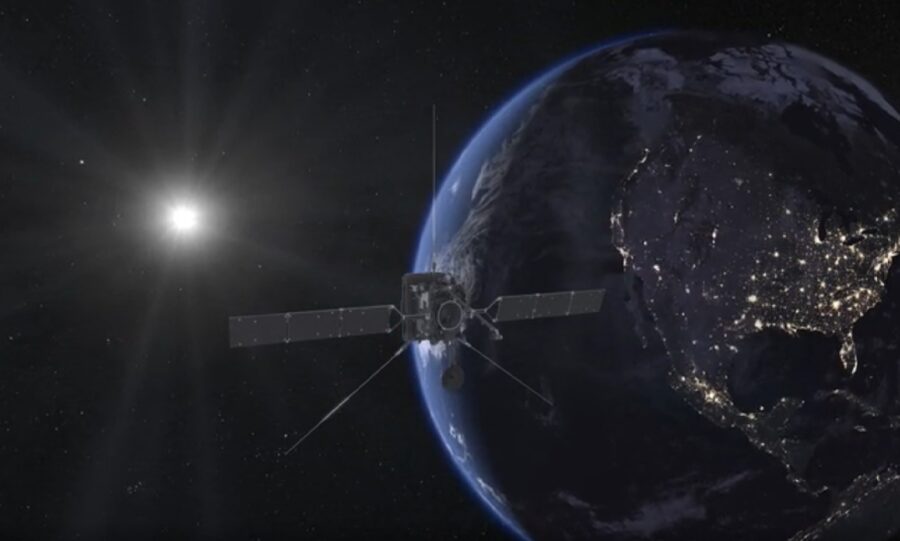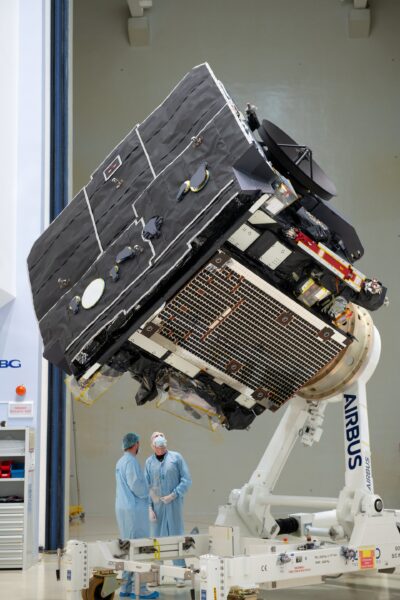The Solar Orbiter mission will fly past Earth Friday night, setting up a dramatic sunward plunge.

A mission to study our host star will visit our fair planet this coming weekend, one last time. Launched on February 10, 2020, from the Cape Canaveral Space Force Station, the joint NASA / European Space Agency Solar Orbiter mission is using a series of planetary flybys to send it deep into the inner solar system. And while Solar Orbiter will make multiple flybys past Venus, it’s only set to pass Earth once, coming right up this weekend.
The pass will occur on Saturday, November 27th, at 4:30 Universal Time (Friday, November 26th, at 11:30 p.m. EST) as the spacecraft passes a mere 460 kilometers (286 miles) above the Atlantic, near northern Africa and the Canary Islands. The pass is just on the upper edge of low-Earth orbit (LRO), which is the zone where satellites and the International Space Station fly at an altitude of 420 kilometers (261 miles) above Earth's surface.

Solar Orbiter will also pass through the outer ring of satellites in geostationary orbit, some 36,000 km above Earth. ESA controllers will assess if a fine-tuning avoidance maneuver is needed hours before the pass: Russia's anti-satellite missile test early last week added to the burden of debris in LEO, all of which must be accounted for.
It may be possible for well-placed observers to spot Solar Orbiter during its flyby Friday night. The spacecraft will enter Earth’s shadow for just over 20 minutes, from 23:28:42 to 23:48:53 UT. This will give observers in Europe and northern Africa a chance to spy the spacecraft prior to closest approach in the pre-dawn hours, and North American observers the chance to see it emerge from Earth’s shadow on its outbound leg. Solar Orbiter should appear as a 8th-magnitude “star” moving about 1° (twice the full Moon’s diameter) every three seconds against the starry background. Heavens-Above has a page dedicated to the event. The site also enables users to plot the spacecraft’s trajectory against the starry background for your given location, another handy feature.
The best way to see Solar Orbiter for yourself is to pre-aim either binoculars or a telescope with a wide field of view at the region of the sky the spacecraft will pass though, then watch at the appointed time. I like to run WWV shortwave radio in the background to get a precise audio time stamp, allowing me to keep eyes on the sky.
🧵 #SolarOrbiter's upcoming #EarthFlyby is special in many ways. As we count down to 27 Nov, we'll share a #FlybyFact on this thread every day!
Need more info now? Watch our 1 min summary👇 or read the full story 👉https://t.co/s9lwFAQoLU #ExploreFarther #WeAreAllSolarOrbiters pic.twitter.com/2PczGM22Ck
— ESA's Solar Orbiter (@ESASolarOrbiter) November 19, 2021
Unistellar is also running a campaign for eVscope users to track Solar Orbiter, enabling users to contribute to the actual science of refining the precise orbit for the mission.
Solar Orbiter Science Planned for Earth Flyby
Solar Orbiter will also be busy during the flyby. The mission will analyze Earth’s magnetic field during the pass, allowing ESA scientists to compare the data with observations from both the four Cluster satellites (in a distant, 60,000-km orbit) and the three Swarm spacecraft in LEO. Observations of interactions between the solar wind and Earth's magnetic field from multiple vantage points will go a long ways towards resolving whether changes detected by spacecraft are changes observed as a result of a region itself changing or as a result of a spacecraft's flight taking it through different environments. (This uncertainty goes by the fancy term of space-time ambiguity.)
“This flyby is exciting: seeing what Solar Orbiter sees in our part of space, and how that compares to what we are seeing, and if there are surprises, what are they?” said Swarm mission manager Anja Strømme (ESA) in a recent press release.

The completion of the Earth flyby also marks the formal start of the mission’s science phase, which will continue until at least 2026. The spacecraft already made one solar pass back in June 2020, which took it 77 million kilometers (0.5 astronomical unit) from our star. During that perihelion, the craft’s instruments spotted enigmatic “solar campfires” in the lower layers of the solar corona, thought to fuel coronal heating. Already, Solar Orbiter has generated more than 50 research papers during the mission’s cruise phase alone. Mission scientists will compare and contrast findings with those from NASA’s Solar Parker Probe, which is studying the Sun from much closer.

Then, Solar Orbiter will make its closest perihelion pass yet in 2022, at just 50 million kilometers (just over 0.3 a.u.) distant. That’s similar to Mercury’s perihelion distance from the Sun. A series of Venus passes over the next few years will also kick the spacecraft out of the ecliptic plane, setting it up for polar passes over our host star starting in 2025 and giving us a view of the Sun we’ve never had before.
If skies are clear, be sure to catch sight of Solar Orbiter this Friday night, on its way to probe the mysteries of the Sun.
 5
5
Comments
Anthony Barreiro
November 24, 2021 at 2:49 pm
Where will the ISS be during the flyby? Will the crew be able to see the Solar Orbiter?
You must be logged in to post a comment.
Anthony Barreiro
November 24, 2021 at 3:15 pm
Whoo hoo! As seen from San Francisco, the Solar Orbiter will emerge from the Earth's shadow at visual magnitude 7.1 at 2047:30 PST, 57 degrees above the horizon in Aries, not far from Uranus. The weather should be mostly clear. I'll be watching.
You must be logged in to post a comment.
David DickinsonPost Author
November 25, 2021 at 11:01 am
Hi Anthony,
Made me look... possibly, the ISS is just emerging from the Earth's shadow over the South Atlantic at 4:30 UT. I'm guessing they really don't have any equipment capable of tracking Solar Orbiter onboard though. Plus, the viewing Cupola is oriented Earthward.
-Dave Dickinson
You must be logged in to post a comment.
Anthony Barreiro
November 25, 2021 at 5:45 pm
Thanks Dave. Happy Thanksgiving.
You must be logged in to post a comment.
Anthony Barreiro
November 26, 2021 at 5:31 pm
I'm disappointed that the astronauts on the ISS can only look down at Earth, not out into space. If I was in low Earth orbit, I would want to take advantage of the perfect seeing and transparency above the atmosphere, and watch the stars not twinkle.
You must be logged in to post a comment.
You must be logged in to post a comment.